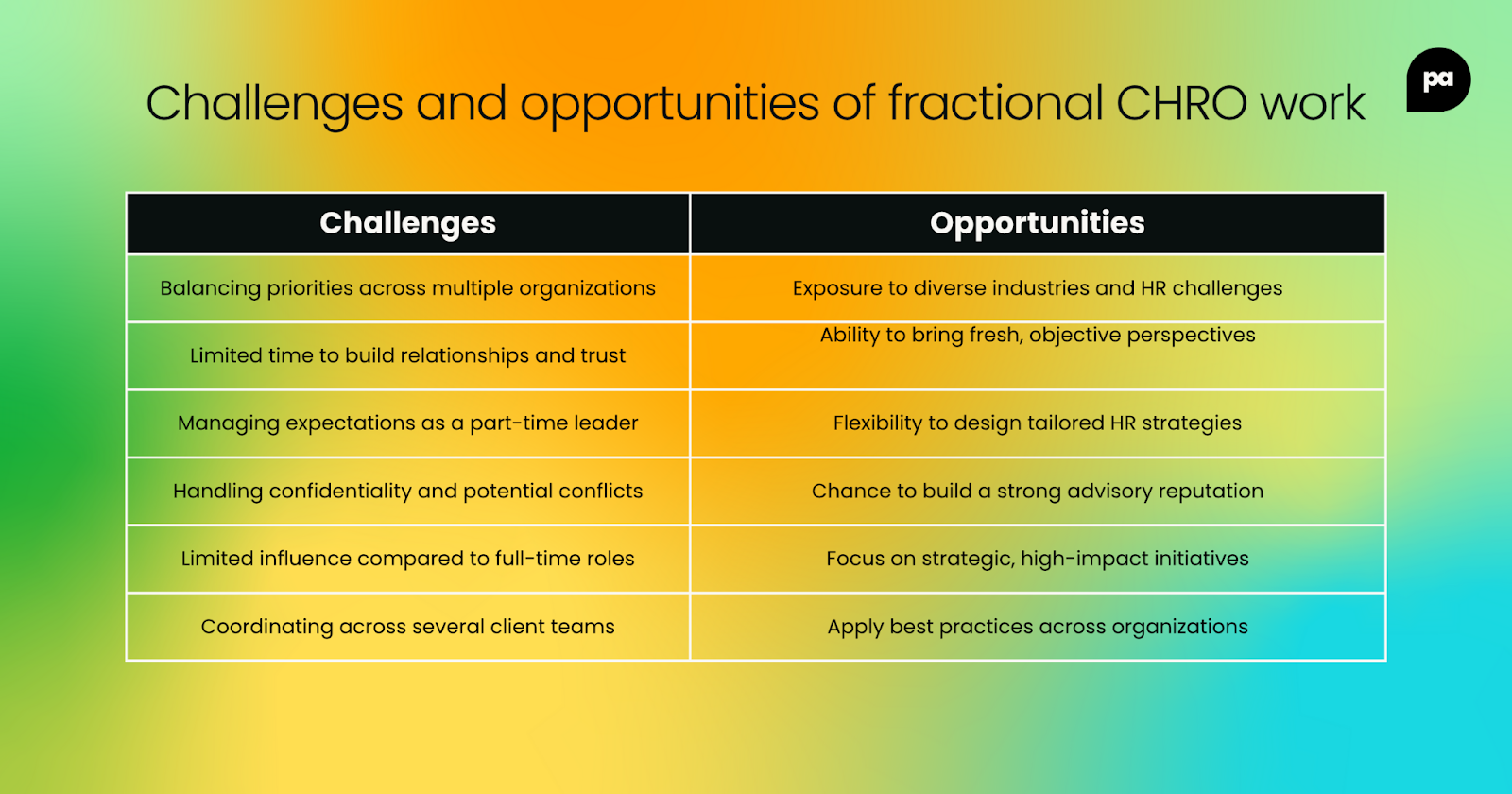“Fractional HR leadership isn’t about stepping back – it’s about stepping in where it matters most. You’re bringing in someone who’s been at the sharp end of transformation, culture change, and board-level HR strategy.” – Barry Flack, seasoned HR strategist and advisor, in conversation with Frazer Jones
Not every company needs or can afford a full-time exec. This is especially true in HR, where small businesses and startups often need high-level strategy but can’t justify a six-figure salary.
This is why becoming a fractional CHRO (Chief Human Resources Officer) can be the right move for your career.
What is a fractional CHRO?
LinkedIn profiles that mention fractional leadership have increased from 2,000 in 2022 to 110,000 in 2024, clearly showcasing these roles are becoming increasingly popular.
A fractional CHRO is a part-time or contract-based HR executive. You’re not tied down to one company full-time; instead, you work with several businesses.
The big difference between a fractional CHRO and an HR consultant: you’re not just swooping in for a quick project or writing up a report and then leaving. You’re part of the leadership team and often work directly with the CEO.
You help shape company culture, guide people strategy, and make sure HR practices truly align with business goals.

Why companies are choosing fractional CHROs
Between hybrid and remote teams, tech changes, rising employee expectations, and labor laws that never stay the same, work has become more complicated than ever.
Many companies are seeking HR leadership to stay ahead.
They’re specifically turning to fractional CHROs for the top expertise without the full-time wage, the flexibility they have to jump in when needed, and the fresh outside perspective from someone who’s seen what works and what doesn’t across different industries or companies.
Fractional CHROs are a perfect fit for startups and mid-sized companies that need this executive-level guidance but don’t have the budget for a full-time position.
Of course, it also helps hugely during transitions, like mergers and acquisitions, leadership changes, and even during investment stages. In fact, the Leadership Capital report from Lcap Group found that 30% of companies that hired a CHRO during the investment period outperformed their peers.
Skills you need to become a fractional CHRO
Stepping into a fractional CHRO role means you’re not figuring things out as you go. Instead, you’re brought in because companies need results fast.
To really succeed, you need the right mix of experience, adaptability, and confidence that earns people’s trust from day one.
Here’s what really counts:
- Strategic mindset: You’re both running HR operations and connecting them directly to the bigger business picture. Think like a business leader first, and an HR leader second.
- Change leadership: Fractional CHROs are often called in when things are shifting (growth, restructuring, or even a full-on crisis). Your job is to steady the ship, guide people through uncertainty, and keep everyone focused on what matters.
- Talent strategy skills: From hiring and retention to succession planning, you’ll need to design systems that help the business grow sustainably.
- Legal and compliance savvy: Employment laws, benefits, equity, DEI requirements are getting more complex by the day. You’re the one who keeps the company out of hot water.
- Executive communication: You’ll be in the room with CEOs, boards, and other senior leaders. Speak their language: clear, confident, and focused on outcomes.
- Adaptability: Every company is different. Some will need you to build HR from the ground up, others just need fine-tuning. The ability to pivot and adjust quickly is crucial.
How to transition into a fractional CHRO career
Making the leap into fractional leadership takes a bit of planning. You’re building a portfolio career, meaning you have to be intentional about how you show up and position yourself in the market.
1. Build deep expertise in people and culture leadership
If you want to charge premium rates and be trusted at the executive table, you need more than a few HR projects under your belt. You need depth: experience across talent, culture, leadership, and strategy.
That might mean you’ve led teams through rapid growth, reorganizations, or culture resets. You’ve probably been the person making tough calls about hiring, performance, or leadership alignment.
“Doing HR work” is different from being a fractional CHRO, since it’s about helping leaders build the systems, people, and culture that allow their company to scale well.
Titles such as Head of People, HR Director, or Chief People Officer demonstrate that you can lead strategy, not just execute tactics. Clients need to know they’re hiring someone who has seen the full employee lifecycle and can create the right systems.
2. Clarify your value proposition
Before you start taking on clients, define what kind of fractional CHRO you want to be. Ask yourself: where do you create the most value?
Maybe you’re best at building a People function from scratch in early-stage startups, or maybe your strength lies in helping post-Series B companies evolve from scrappy to structured.
Think about your signature strengths (leadership development, culture and engagement, compensation strategy, or organizational design) and make that your differentiator.
You’re not just “offering HR help”. You’re offering clarity, alignment, and the systems that allow people and culture to drive business growth.
Your positioning should make this obvious. Instead of saying “I help companies with HR”, say “I help scaling startups build leadership capacity, define culture, and retain their best people through strategic people systems”.

3. Create a clear and compelling offer
C-suite executives value simplicity, so make your offer easy to understand. Define what you do, what results you deliver, and what the engagement looks like.
Many fractional CHROs work on a retainer model (for example, 10 to 20 hours a week for a flat monthly fee) but you can also offer project-based engagements for things like designing a performance framework, leading an executive offsite, or developing a compensation structure.
What matters most is clarity. Outline what clients get, the results you’ll drive, and how success is measured. Create a short, polished one-pager that explains your services, scope, pricing, and process.
Remember: you’re not charging for your time, you’re charging for transformation and for helping an organization mature its people strategy in ways that directly improve performance and retention.
4. Build your personal brand
As a fractional CHRO, your reputation is everything because you’re selling trust and expertise, and people need to see both before they hire you.
Build a visible online presence that reflects your thinking and leadership style.
LinkedIn is your best stage. Share insights a few times a week about what’s working (and what’s not) in modern people leadership: lessons from your experience, frameworks you use, or observations about how culture shapes growth.
Engage with founders, investors, and HR peers to stay visible in your ecosystem.
A simple website or portfolio that showcases what you do, who you’ve helped, and the results you’ve achieved can reinforce that credibility. Add case studies where possible, even one or two strong examples can make a big difference.

5. Start getting clients
Your first clients will likely come from your existing network (a.k.a., people who already trust you), so reach out to former colleagues, founders, or investors and let them know you’re taking on fractional engagements.
Be direct but helpful: offer insights, share resources, or comment thoughtfully on their challenges.
You can also look for opportunities by observing companies that are growing fast but don’t yet have a strong People function. A personalized message to a founder highlighting what you’ve noticed can open doors.
Joining founder communities, Slack groups, or industry networks where decision-makers gather can also help. And if you prefer a more structured approach, fractional talent platforms like AdvisoryCloud or Toptal can be a good place to start.
6. Set up the right systems
Running your own fractional practice means you’re also your own operations team, meaning you need to have a structure in place to ensure you’re organized and professional.
Develop a consistent onboarding process with clear steps: for example, an intake form for goals and pain points, a kickoff call, and a way to document deliverables and metrics.
Use proposal and contract templates to set expectations around scope, billing, and exit terms, as well as tools like Calendly, Notion, and project dashboards, which can help you look polished and organized.
Your goal should be to create systems that are repeatable for each new job you get, so you don’t have to create everything from scratch every time.
7. Focus on strategic impact, not HR admin
Your value as a fractional CHRO doesn’t come from running payroll or managing day-to-day HR tasks, it comes from setting the direction that shapes how people work and thrive.
That means you should focus your energy on organizational design, leadership alignment, performance strategy, and culture development.
Let internal HR teams or consultants handle the execution side of things. The more time you spend on strategic decisions (structure, capability, and culture) the greater your impact.
And, of course, the higher your value and the more you can use as a case study for your next engagement.
8. Learn to say no
One of the biggest shifts when going fractional is learning to turn down work that isn’t a fit. It can be tempting to accept anything to get your foot in the door, but this will waste your time and energy and not help you build your reputation as a fractional CHRO.
You shouldn’t be an HR generalist-for-hire. Your value lies in deep, high-impact partnerships with companies that respect your expertise.
If a potential client wants a “hands-on” HR manager but not a strategic partner, it’s okay to walk away.
Protect your time for the clients who see you as a trusted advisor, l helping you build your reputation as someone who delivers meaningful, lasting change.
9. Optimize and evolve
Once you’re fully booked, focus on refining your model, including reviewing your workload and client mix regularly, adjusting your rates or tightening your scope as demand grows.
You should also be encouraging referrals from satisfied clients and investing in your own learning.
The world of people leadership is evolving fast, from AI-driven talent tools to new expectations around remote culture and wellbeing. You have to stay current, curious, and close to the real problems your clients are facing.
Stay relevant and in demand.

Mistakes to avoid when starting out as a fractional CHRO
Underpricing yourself
It’s important you keep in mind that you’re not a consultant doing ad-hoc HR projects or an interim manager filling a temporary gap, but a senior operator who brings strategic leadership and organizational insight.
When you undervalue your expertise, not only do you set the wrong expectations with clients, you limit your own capacity to attract the right kind of work.
Overselling execution
Many fractional CHROs start out trying to prove their worth by doing everything, including writing policies, running training sessions, and managing day-to-day HR admin.
The problem is that you end up operating at a level far below your value. Your job is to guide and shape, to lead strategy, design frameworks, and help founders make better people decisions.
If you spend all your time executing, you’re not showing up as the strategic partner they actually need.
Saying yes to everything
As we’ve seen, it can be tempting, especially early on, to say yes to every opportunity. A potential client reaches out, a friend recommends you and, before long, you’re juggling five clients with no time to think.
But saying yes to everything usually means spreading yourself too thin and doing mediocre work for everyone. The best fractional CHROs are selective because they choose clients who value people as a strategic advantage and who are ready to implement meaningful change.
Jumping in without clear scope
When you’re fractional, boundaries are everything. Without them, you’ll end up trying to do too much or being pulled into responsibilities that don’t belong to you.
Before you start, define your focus areas, set expectations for deliverables, and agree on success metrics. Get it all in writing to protect both you and the client.
Forgetting to document results
You might know you’ve transformed a company’s culture or improved retention, but if it’s not tracked, it’s invisible.
Record your wins (improved engagement scores, reduced turnover, stronger leadership alignment) and use them to show measurable impact.
Future clients won’t just want to hear that you’re good, they’ll want proof.
Not aligning with founders
You can’t build a thriving culture if leadership isn’t bought in or your work isn’t tied to the company’s goals. Make time for regular check-ins with the CEO or founders to ensure your strategy supports their broader vision.
The most successful fractional CHROs are those who bridge the gap between people and business outcomes seamlessly.
Trying to scale too fast
You might see everything that needs fixing and want to introduce new tools, systems, and frameworks all at once.
But not every company is ready for that level of sophistication. Start with the foundations, such as values, performance, communication, and leadership habits, then build from there.
Fractional work is about meeting companies where they are, not dragging them to where you think they should be.
Not marketing yourself
When you’re busy supporting your clients, it’s easy to let your own brand slide, but that’s a mistake.
The best fractional CHROs treat their visibility as part of their business.
Share insights from your work (without breaching confidentiality), talk about what you’re learning, celebrate milestones, and show people how you think.
It keeps you top of mind and builds a referral network that does the selling for you.
Pros and cons of being a fractional CHRO

In short
Becoming a fractional CHRO gives you the freedom to design your own path, the control to choose who you work with, and the variety that comes from shaping the people strategy across multiple organizations.
If you’re ready to guide founders, build strong cultures, and drive transformation while earning on your own terms, now’s the time to lead your way.
Sign up to our (free) Insider membership to receive expert insights, templates, on-demand videos, and so much more, to help you level. up your people leadership skills.




 Follow us on LinkedIn
Follow us on LinkedIn





